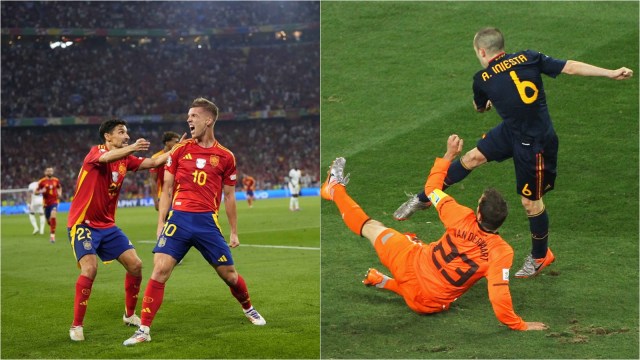
The same right wing, the same No 22. The number—and in his peak the wing too—belonged to Jesus Navas, the Spanish full-back, the lone link between the 2010 World Cup champions and the Euro 2024 finalists. He was the common thread in conceiving both goals, fourteen years apart.
Introduced as a substitute in the 60th minute with the brief to “try and push forward to create danger” he did exactly that. In the 115th minute of the tense final, he gathered the ball from the edge of the touchline in his own half, twisted past his marker Rafael van der Vaart, sprinted upfield, cut infield, ran into heavy traffic, lost his balance as two Dutch defenders converged onto him, a third rushing onto him. But still he had the will to scamper the ball to Andres Iniesta, who conjured a sumptuous back-heel to Cesc Fabregas near the centre-line. The latter passed the ball back to Navas, it didn’t have the required weight, but he ran back to collect the ball and pick Fernando Torres on his left. The striker’s pass was wayward but it bounced off van der Vaart in the box. An aware Fabregas pounced on it and slipped the ball wide to Iniesta in the box. The virtuoso midfielder took a calm touch, the ball reared up and he hammered a shot past the goalkeeper into the bottom left corner.
A decade and four years later, history would nearly repeat itself. The Sevilla-legend, famously homesick, was involved in another historic goal for his country. Soon after the sensational Lamine Yamal strike, the teenager slithered a pass to Dani Olmo, hovering near the box. He saw traffic in front of him, but turned right to see Navas on the far right channel. The 38-year-old had endured a torrid night as Kylian Mbappe out-speeded and out-thought him, but here he had made the deep run to join the attack. Navas’s cross had all the rustiness of someone who was restricted to cameos. But French defender William Salib cleared the ball away, but only till Dani Olmo, another high-class technician like Iniesta.
The ball was travelling at a decent velocity when Olmo’s right foot intervened. The first touch sucked all its moments. With the second, from the outside of his boot, he diverted the ball to his right, before he pirouetted to the direction of the ball, all in one fluid movement of control and dextrousness. The manoeuvre beat Aurélien Tchouaméni. And then he slid the ball through the space between Dayot Upamecano and Mike Maignan. Jules Kounde, from the back-pos lurched in, but could only clip the ball onto his own net. Why he didn’t slide full-throttle is a mystery, maybe France had yet to recover from the Yamal blow.
The two moments sum up the Navas irony. He was a jet-heeled winger born in the wrong era of tiki-takians. His biggest gift, speed—so quick that he once ran 100m in 10.8 seconds and broke a running machine—was deemed surplus for that era of Spanish football.
A misfit to the triangular-passing fixated squad, his appearances were scattered, and mostly as an impact substitute. Shortly after Spain defended their Euro crown in 2013, he was axed and waited for another six years for his comeback. In the interlude, Pep Guardiola converted him into a right back, as he seldom deployed a pure winger. Besides, his crossing was not always defence-splitting and rarely scored goals. In Guardiola’s second year, City packed him to Sevilla. He returned to the national fold in 2019, then was ditched after a year. At 34, it seemed he would never play for his country again. But new coach Luis de la Fuente recalled him 10 months ago, and he became Spain’s oldest player to feature in a major tournament.
Now, at a time when Spain are uncharacteristically relying on two wingers, he has aged. Born in the wrong era, but born for the big moments nonetheless.





